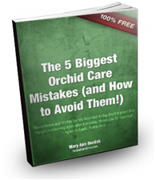 Orchid care has come a long way from the old days. It has been refined and made easier. These plants can now be cultivated anywhere from greenhouses to the comfort of your own home. Basically all plants have the same requirements as orchids, but in order to grow orchids successfully there is a certain combination of factors that are needed.
Orchid care has come a long way from the old days. It has been refined and made easier. These plants can now be cultivated anywhere from greenhouses to the comfort of your own home. Basically all plants have the same requirements as orchids, but in order to grow orchids successfully there is a certain combination of factors that are needed.
To make sure your orchids are always healthy and happy, follow these 6 laws of successful orchid care…
1. Provide the correct levels of humidity. Orchids are originally found in the tropics, where the weather is hot and humid. That is why these plants must be given no less than 40% humidity and no more than 70% during the day.
Unlike most plants orchids lose moisture very quickly. When the weather is warmer, be sure to provide moisture in any way you can.
Humidity can be increased in many ways: watering the plants more than the usual, misting, or even relocating them to a more humid place in the house will do. The opposite must be done during cooler temperatures.
Too much moisture can also kill the plant so be sure to provide adequate drainage.
If you do not fulfill this important requirement, after a few days, you will notice your plants will wilt. You will know that you are not providing the correct amount of humidity for them through its appearance. Not enough moisture turns leaves yellowish while too much makes the plant fragile.
2. Make sure that they can breathe fresh air. Most orchids are classified as epiphytes, which means they live “up there”. As for most orchids in the wild, they are found on branches and birch trees. They live specifically there to feed off of the moisture and nutrients surrounding them.
Compared to most plants orchids make use of carbon dioxide more efficiently. That is why proper ventilation is a must to any orchid – either in the wild or in cultivation. A modern air conditioning unit can solve this problem. Most of these units produce warm and humid or cool air depending on the season.
Not all types of air is good for orchids. Cold drafts and dry hot air can freeze and wilt orchids respectively, which can cause these plants to wither.
3. They must have the proper amount of sunlight. The rule of thumb for orchids is that these plants must be given the maximum amount of sunlight they can stand without causing any injury to them. This is quite difficult to tell because sunlight requirements differ from species to species. One way to find out its requirements is though experimenting.
Most orchids require sunlight in order for it to produce blooms. Some, though, do not require it whatsoever. You can check if the orchid is getting the proper amount of light it needs by looking at its leaves. Yellow leaves mean it needs less light while dark green ones means it needs more light.
4. Protect orchids from the harsh cold. Again, because most orchids come from tropical countries, extreme cold can damage these plants. Although orchids also need cooler temperature at night to produce blooms, snow and frost can be detrimental to their growth.
Cold temperatures can slow the growth of orchids and can even make their leaves brittle. You can protect these plants through shelters or structures such as greenhouses. Some orchids can stand extreme cold but not for a long time. At the most an orchid can stand a total of two weeks’ time in a really cold place; more than that will kill them.
5. Feed them adequately. Growing on trees, orchids also rely and feed on nutrients from dead leaves and animal droppings. In cultivation, these natural conditions are not available. Providing them with the right kind of fertilizer will make up for this.
Nutrients can start from the compost you use. Osmunda and leafmold are two of the favorite potting mediums used in orchid care. Then once a month feed the plant food either liquid fertilizer or ground manure. Be sure though that at the end of each month you wash off the salt residue that builds up due to fertilizers.
Another thing to remember is not to over feed them. Too much fertilizer can burn the plants or can even kill them entirely.
6. Do proper research. Because there are so many types of orchids, no specific orchid care system can fit all of them. The requirements for the different types can vary hugely from each other.
You can ask the place where you bought them or do some research online. There is actually a lot of information available if you just take a little time to look. In order to be successful in growing orchids you must NEVER skip this important step.
Orchid care is not an exact science because orchids themselves have many species and each one has different needs. If you follow these 6 laws, then in no time you will have grown healthy orchids to last you for years.
And to learn even more about orchid care, download my totally FREE 5-Day Orchid Insider training course by going here: Orchid Care Help.




Thought the 6 points arnk youe great advise for both experienced and beginers. Tha
Thanks, John. 🙂 I appreciate your kind comment. – Mary Ann
Thank you for all the good care tips. My question is that I have 1 phal orchid and it lost all of it’s leaves. I didn’t realize that it was in a tight plastic pot inside I of the clay pot. I took it out of the plastic pot and it looks like the roots are still light colored and alive. It was planted in Spanish moss. The moss was also way too tight. I soaked it, completely loosened the moss and put in a plastic pot with holes.Do you think it’s savable? Any advice? Thank you
Yes I do. It sounds like you’ve acted quickly to fix the problems. Now just continue to provide it with the proper care, and see what happens! 🙂 – Mary Ann
Hello, I think the sunlight requirements are reversed. I’ve read dark green leaves mean the plant needs more light. Which means I have to move my plants around! 🙂 Thanks for the tips.
You’re right! So sorry about that! Thanks for catching that mistake. – Mary Ann
Hi! I have 2 vandas. And they upper leaves starting to withered, but the roots is very healthy. What will i do? And what will i do for them if i go for 3 days vacation w/o caring for them in 3 days? I need help really
Have you seen our article about vanda care? Also, your vanda should be ok for only 3 days. They are naturally found in environments where they get a ton of water for a while (maybe hours or days) and then they have dry spells. Make sure there’s good drainage and air flow and the temperature in your house stays the same, and you should be fine. Thanks! – Mary Ann
Please give me a answer! After Ballara Tahoma Glacier has bloomed and wilted do you cut off the stem or leave it ? Have sherry baby too, and asking same question. Also cymbidium Lady Angus, same question. I’ve looked everywhere for answers. Not one book has answer. Gloria
Hello Mary Ann
Thanks for wonderful articles.
You’re welcome! Thanks for your nice comment. 🙂 – Mary Ann